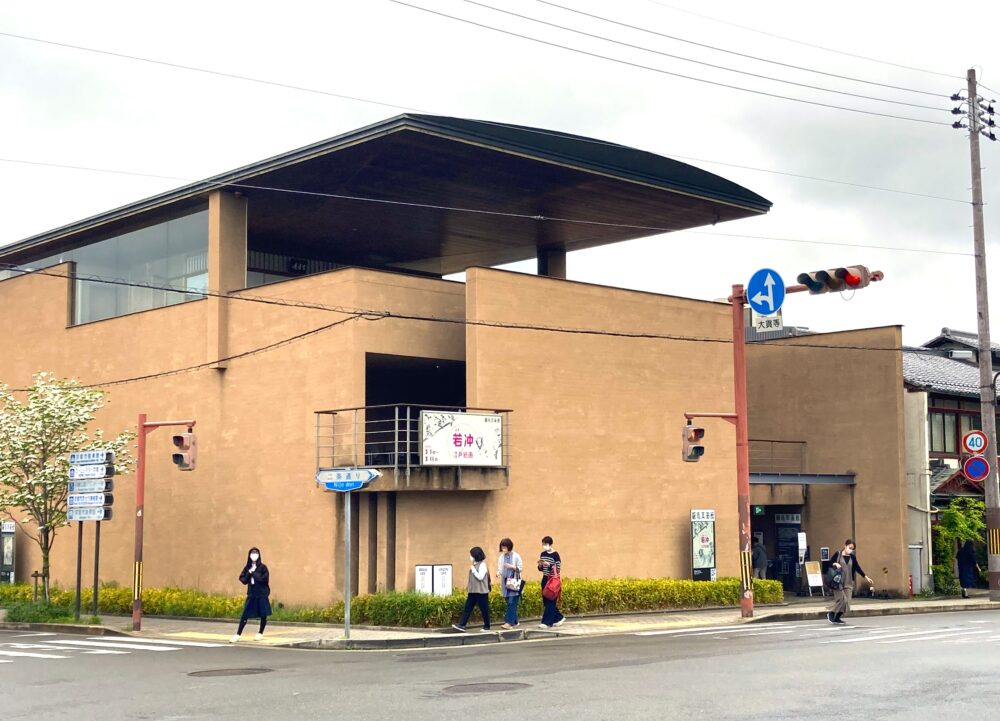
The best place in Kyoto to see Jakuchu’s art — and amazing Rinpa masterpieces, too!
Located in the Okazaki area near Heian Shrine, the Hosomi Museum is a calm and elegant art museum that quietly captivates visitors with its refined atmosphere and rich collection spanning from ancient to modern Japanese art.
The museum’s architecture is unique. The galleries stretch from the first floor down to two basement levels. On the lower level, there’s a sunken garden called the “Sankun Garden,” where natural light and silence create a peaceful space. The building itself is beautifully designed to enhance the artwork on display.
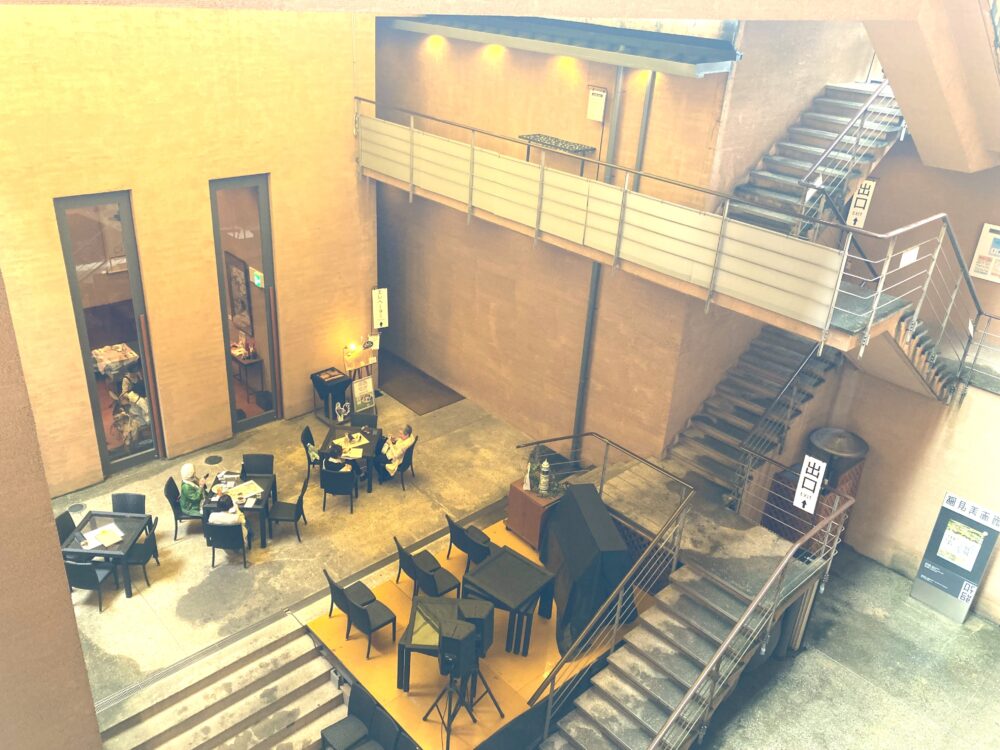
The highlights of the collection are Ito Jakuchu and the Rinpa School.
You can explore Jakuchu’s artistic journey—from early works like Rooster in the Snow to his later masterpieces. As for the Rinpa School, the collection includes works by its founders Tawaraya Sotatsu and Hon’ami Koetsu, as well as later artists such as Sakai Doitsu and Kamisaka Sekka. The quality and range are so remarkable that the museum is sometimes called “The Museum of Rinpa.”
Although the museum is not large, the intimate layout allows you to appreciate each artwork closely and at your own pace. On the lower floor, you’ll also find a cozy café and restaurant—perfect for relaxing and reflecting after your visit.
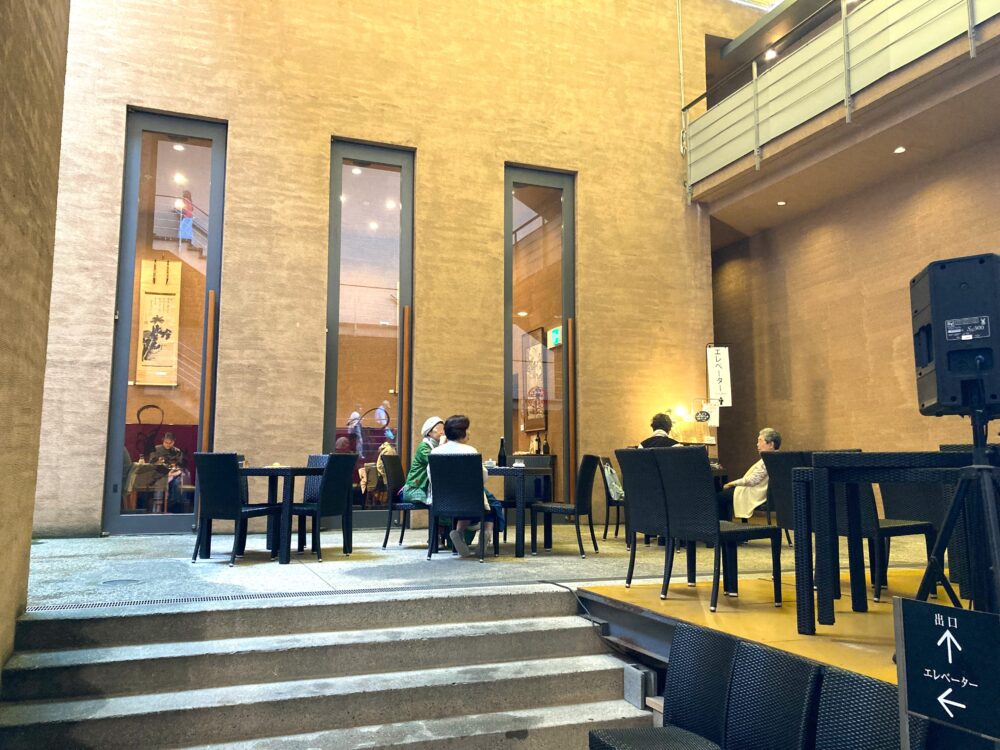
Highlights from the Hosomi Museum Collection
The main attractions of the Hosomi Museum are definitely the works of Ito Jakuchu and the Rinpa School.
Here are some must-see pieces to look out for during your visit.
Jakuchu Ito
“Rooster in the Snow” (Setchu Yukei-zu, ca. 1747–1751)
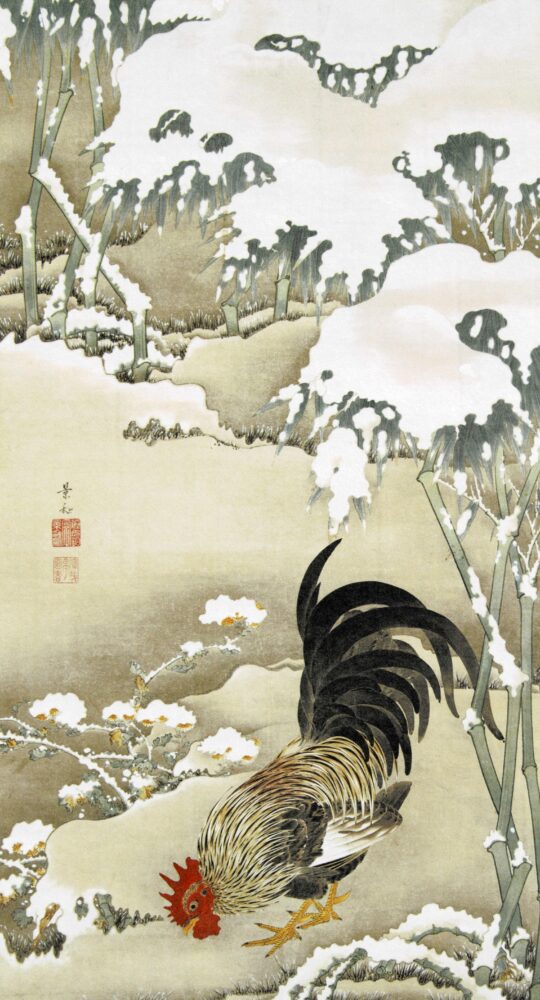
About This Work (Tap or Click to View)
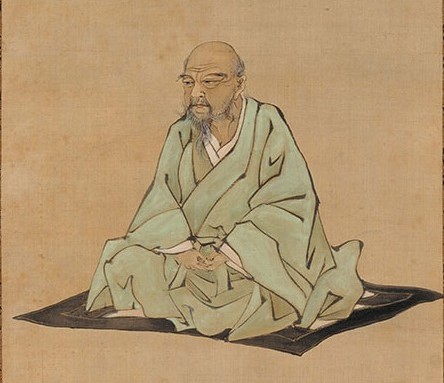
Jakuchu’s Beloved Rooster — A Signature Work of the Hosomi Museum
When you think of Jakuchu Ito, the first image that comes to mind is often a rooster.
He painted roosters again and again throughout his career, exploring their color, form, and spirit in his own unique style. Even today, his bold use of color and composition feels surprisingly modern.
The Hosomi Museum owns one of these early masterpieces — “Rooster in the Snow”.
It was created before Jakuchu retired from his family business to focus fully on painting, making it a rare work from his formative years.
The Birth of Jakuchu’s “Rooster” Theme
Although Jakuchu is often called an eccentric painter, his early training was quite traditional.
He studied the Kano school and copied Chinese Song and Yuan paintings — a common practice known as copy-based learning (funpon shugi).
But soon he began to search for his own subjects, turning his attention to the plants and animals around him.
Among them, the rooster became his ideal motif — easy to observe, richly colored, and full of life.
In Rooster in the Snow, you can already feel Jakuchu’s deep affection for this bird.
A proud rooster stands in a snowy bamboo grove.
The composition is simple yet striking — the quiet coldness of the snow contrasts beautifully with the rooster’s powerful presence.
Each feather is painted with delicate brushwork, and the natural posture gives the bird a sense of calm dignity — almost like a lone samurai.
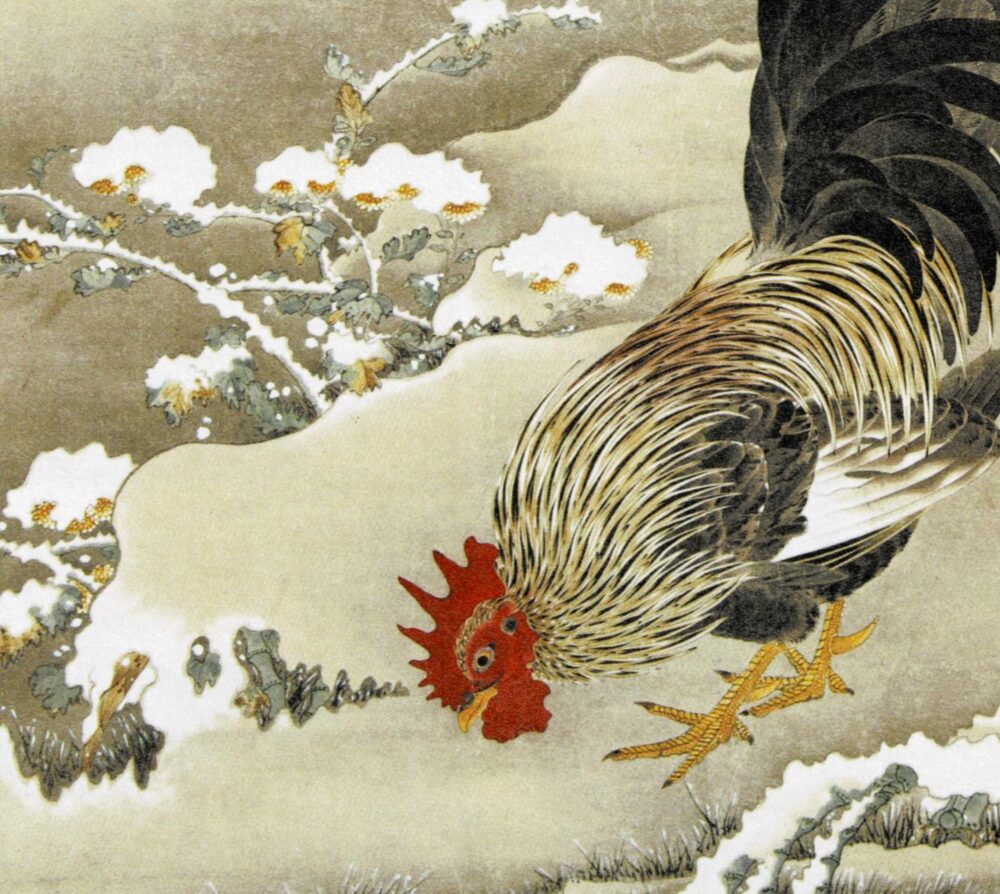
The Deeper Meaning Behind the Rooster
While we usually think of roosters as common farm animals, in ancient China they carried a much deeper symbolism.
According to the Han Shi Wai Zhuan, the rooster embodies the Five Virtues: wisdom, courage, loyalty, benevolence, and faith.
It was considered a symbol of moral excellence.
We don’t know whether Jakuchu was fully aware of this symbolism,
but when you look at his rooster in Rooster in the Snow, you can sense something beyond simple observation — a feeling of admiration and respect.
Interestingly, another early rooster painting by Jakuchu can be found at the Fukuda Art Museum in Arashiyama, Kyoto.
If you have time, it’s definitely worth visiting both museums to see how Jakuchu’s style developed.
▶ Check out our [Fukuda Art Museum article] for more details.
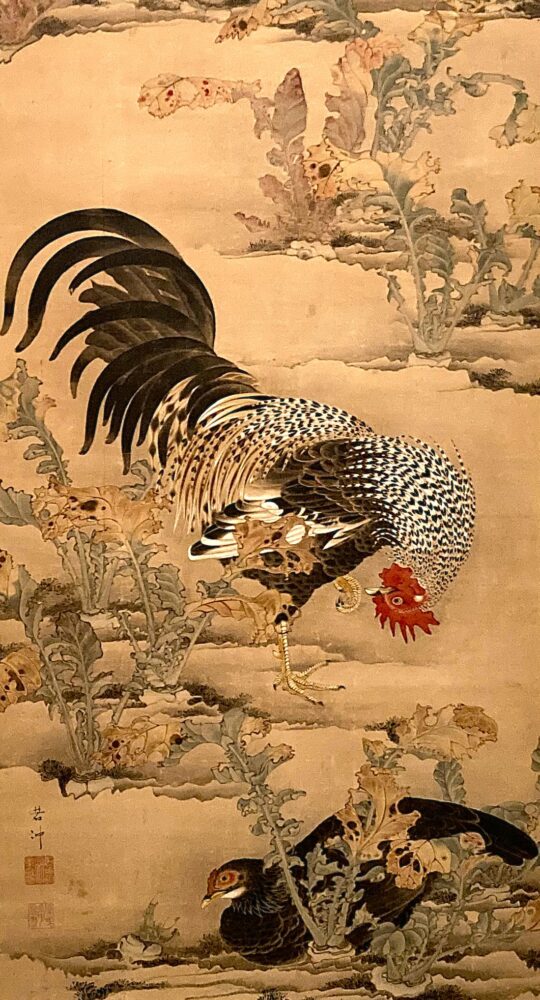
Jakuchu Ito
“Chickens” (Gunkei-zu, ca. 1796)
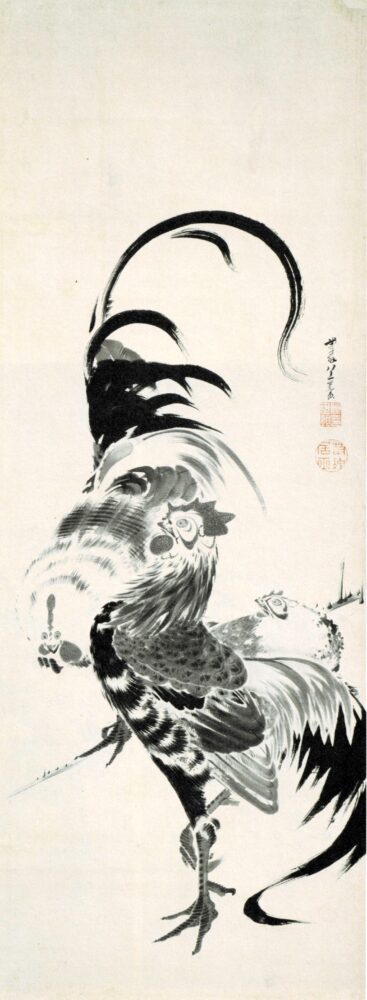
About This Work (Tap or Click to View)
Beyond Color — Jakuchu’s Subtle Beauty in Ink
This late work by Jakuchu Ito, “Chickens”, shows a very different side of the artist.
Unlike the vividly colored “Rooster in the Snow”, this is a monochrome ink painting full of depth and refinement.
Many people associate Jakuchu with bright colors, but his ink paintings reveal another kind of brilliance.
Without color, his brushwork takes center stage, and the balance of tension and open space — a hallmark of ink painting — becomes even more striking.
Dynamic Composition Drawn with Flowing Lines
What catches your eye first is the elegant flow of the composition.
The movement of the chickens forms an S-shaped curve across the painting, giving it rhythm and energy.
Jakuchu’s bold yet controlled brushstrokes create a lively sense of motion that feels almost musical.
The tail feathers, drawn in pure ink, look almost like calligraphy — powerful yet graceful.
With just one color, Jakuchu achieves incredible expressiveness and sophistication.
Compared to his colorful works, the details here are simplified.
But that simplicity is intentional — it highlights the strength of the composition and the natural poses of the chickens.
Every line is essential, and nothing is wasted.
This “less is more” approach shows Jakuchu’s refined skill and mature sensibility in his later years.
Through minimal lines and subtle shades of ink, he brings the chickens vividly to life — proof of an artist who had mastered both control and expression.
Jakuchu Ito
“Snake Gourds and Insects” (Hechima Gunchu-zu, ca. 1753–1754)
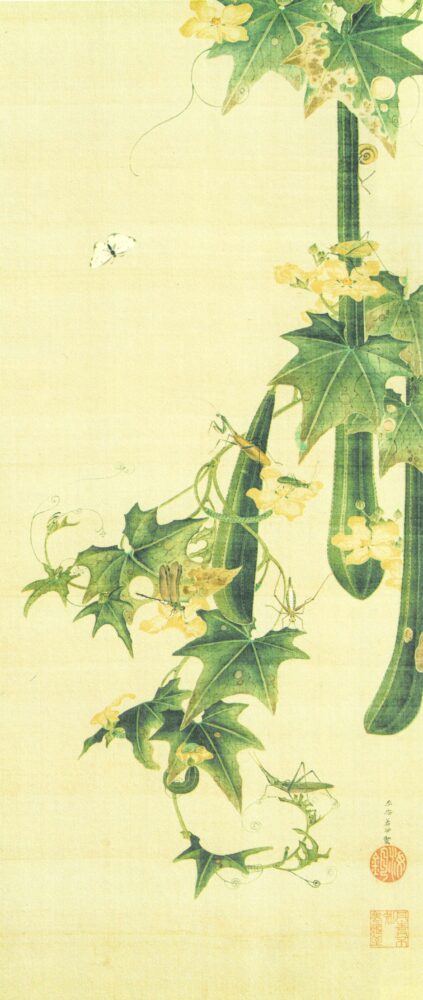
About This Work (Tap or Click to View)
Snake Gourds and Tiny Creatures — Jakuchu’s Gentle Gaze on Everyday Nature
Jakuchu had a deep love for the natural world around him.
He often painted not only animals but also plants, observing them with great care.
In “Snake Gourds and Insects”, he captures a quiet yet lively scene filled with tenderness — showing how he found beauty even in the simplest things.
What first catches your eye is the long, slender gourd stretching across the screen.
Its exaggerated shape feels a bit comical and charming at the same time, giving the composition a playful rhythm.
The clean vertical lines of the gourd create a striking sense of movement that makes this painting uniquely Jakuchu.
A “Small World” Full of Life
If you look closely at the leaves and flowers, you’ll find tiny creatures — mantises, grasshoppers, butterflies, and more — all painted with exquisite detail.
Though small, each insect has a strong presence, turning the surface of the leaves into a miniature ecosystem of its own.
Within the calm and delicate atmosphere of the painting, there’s a subtle feeling of liveliness.
By taking a closer look, you can almost sense how much time and affection Jakuchu poured into observing and painting these small forms of life.
Step back to enjoy the elegant composition of the gourds,
then lean in to discover the hidden insects one by one.
You may find yourself saying, “Oh, there’s another one!” — a perfect example of the quiet joy that comes from truly looking at Jakuchu’s art.
Hoitsu Sakai
“Cherry Blossoms and Small Bird” (Sakura ni Shokin-zu, ca. 1818–1828)
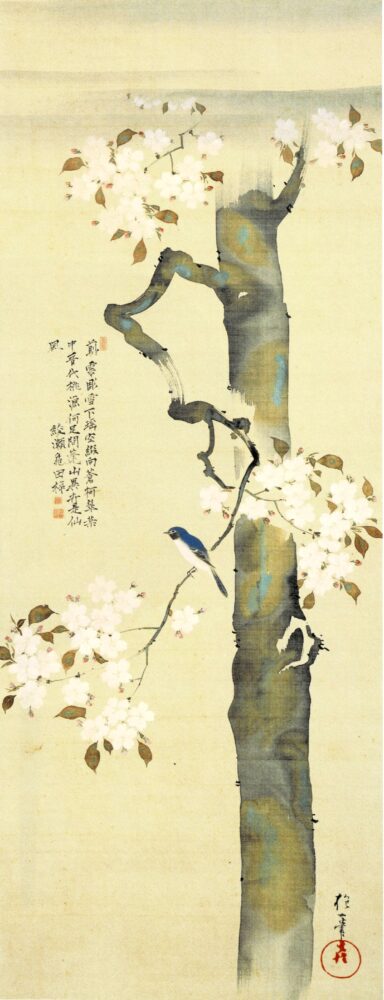
About This Work (Tap or Click to View)
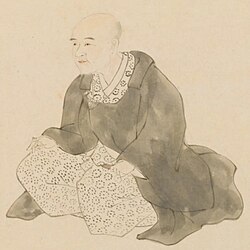
Hoitsu Sakai — The Master of Edo Rimpa
Hoitsu Sakai was a leading painter of the Edo Rimpa school, a style that flourished in Edo (modern Tokyo).
He is best known for “Flowering Plants of Summer and Autumn“, painted on the back of Ogata Korin’s famous Wind and Thunder Gods.
While the Rimpa style is known for its gold leaf and decorative patterns, Hoitsu developed his own approach.
His paintings retain Rimpa’s elegance but are more delicate and poetic, blending realism with quiet beauty.
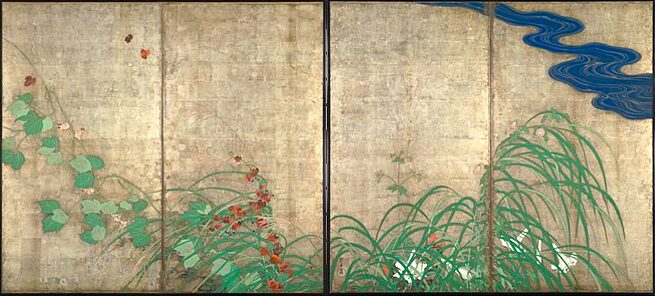
Collection of the Tokyo National Museum
A Painting That Feels Like Poetry
“Cherry Blossoms and Small Bird” beautifully captures Hoitsu’s refined style.
It is believed to represent “March” from his Twelve Months of Flowers and Birds series, depicting the gentle arrival of spring.
A small bird perches gracefully on the trunk of a cherry tree, surrounded by soft blossoms.
The trunk fades into a misty haze as it rises upward — a subtle expression of spring’s warmth and airiness.
The scene feels light and dreamlike, as if drifting into a world between reality and poetry.
On the left side of the painting, a Chinese poem by scholar Ayase Kameda is inscribed.
The verse describes blossoms so pure they seem carved from clouds and snow,
comparing them to flowers blooming in a mythical paradise.
Whether Hoitsu painted first and the poem followed, or vice versa, we cannot be sure.
But what’s clear is how naturally poetry and painting blend together — both sharing the same tranquil spirit.
The soft words and gentle colors resonate with each other, creating a quiet emotional harmony.
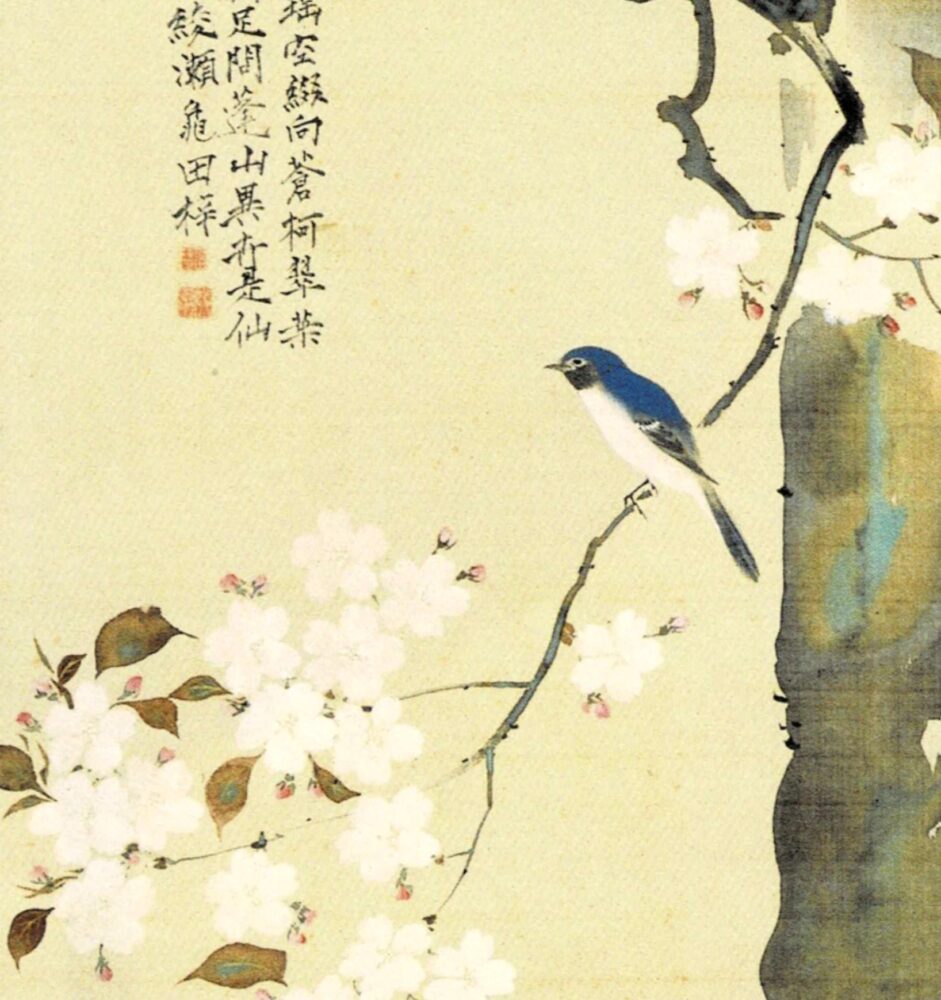
The Essence of Japanese Painting
Floating cherry blossoms in mist.
Snow-white petals that “cut through clouds.”
A single blue bird resting on a branch —
Together they form a scene that feels both still and alive, fleeting yet eternal.
In this one piece, you can feel the essence of Japanese painting —
the precise technique of the Kano school, the decorative elegance of Rimpa, and the popular sensitivity of Ukiyo-e.
Hoitsu Sakai absorbed all of these traditions and transformed them into his own artistic language.
Painted in his later years, Cherry Blossoms and Small Bird stands as a quiet masterpiece —
a work that sums up the spirit of Japanese art from the mid-Edo period.
Kiitsu Suzuki
“Duck by the Water’s Edge” (Mizube Ahiru-zu Byobu)

About This Work (Tap or Click to View)
The Successor of Hoitsu Sakai and the Edo Rimpa Tradition
Kiitsu Suzuki was a prominent painter of the Edo Rimpa school.
As a disciple of Hoitsu Sakai, he inherited and expanded the Rimpa tradition, becoming known as Hoitsu’s artistic successor.
His celebrated work “Mountain Stream in Summer and Autumn” was designated an Important Cultural Property in 2020. The piece showcases the Rimpa style’s decorative beauty through rich use of gold and blue pigments. At the same time, the geometric patterns in the foliage lend it a modern and abstract feel.
If Hoitsu Sakai unified diverse artistic styles into Rimpa, Kiitsu Suzuki broadened its range, giving it a fresh, contemporary interpretation.

Collection of Nezu Museum
“Duck by the Water’s Edge” — Bringing Everyday Life into Rimpa
Suzuki’s playful personality shines in “Duck by the Water’s Edge”.
A group of ducks toddles toward the water, each with slightly different poses and expressions that naturally make viewers smile.
The composition is strikingly simple—just a curved shoreline and a marching line of ducks—yet it feels bold and elegant in its minimalism.
What’s fascinating here is the subject itself.
Instead of mythological dragons, majestic gods, or luxurious flowers, Suzuki painted something ordinary—ducks, simply walking. And they’re irresistibly cute.
While Rimpa art is often associated with lavish and refined imagery, Suzuki brought in a touch of humor and everyday charm, giving the style a fresh sense of life.
This screen beautifully blends Rimpa’s decorative grace with a sense of warmth and personality.
The white ducks lined up across the golden background feel both timeless and familiar—crossing the boundary between classical art and modern sensibility.
When viewed alongside other Rimpa works, the unique charm of Kiitsu Suzuki becomes even more apparent.
At the museum, take a moment to stand before this delightful screen and enjoy the sight of “marching ducks” that continue to capture hearts across centuries.
Doitsu Sakai
“Chrysanthemums, Gentians, and Small Birds” (Kiku Rindo ni Shokin-zu)
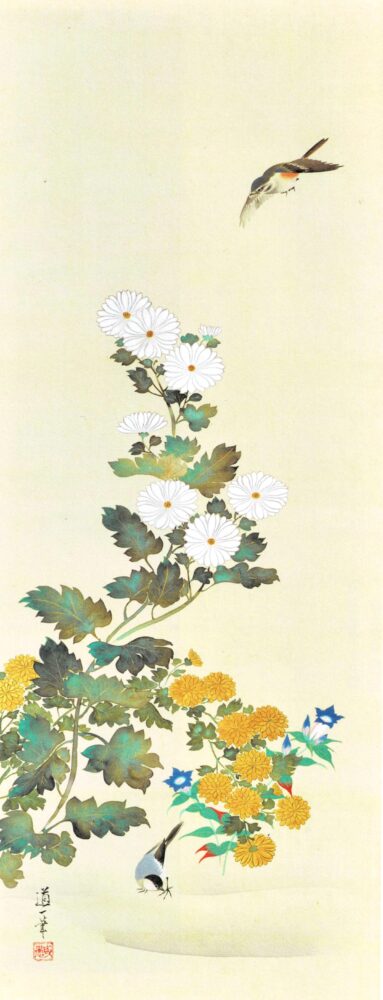
About This Work (Tap or Click to View)
The Successor of “Uge-an” — The Edo Rimpa Legacy
Hoitsu Sakai, the founder of the Edo Rimpa style, established his residence and studio in the Negishi area of Edo (now Tokyo) in 1809.
He named it “Uge-an” (Rain-Flower Hermitage)—a title that later became his artist name and a symbol of his artistic circle. Over time, this studio grew into a creative hub for Rimpa followers.
Many students gathered under Hoitsu’s guidance, including Kiitsu Suzuki and Koson Ikeda, who would go on to shape the later Rimpa school.
Among them was Doitsu Sakai (1845–1913), the fourth successor of Uge-an, who carried the Edo Rimpa spirit into the Meiji era.
He exhibited at the First National Industrial Exhibition (1877) and even produced works for the Emperor Meiji, bridging traditional aesthetics and modern sensibilities.
Rimpa in the Meiji Era
This work, “Chrysanthemums, Gentians, and Small Birds”, is believed to have been commissioned during the Meiji period.
It depicts white and yellow chrysanthemums, blue-violet gentians, and two small birds—classic Rimpa motifs, yet expressed with a fresh, modern touch unique to Doitsu Sakai.
One branch of chrysanthemums extends elegantly from the left, while a bird descends from above as another gazes quietly at the ground.
The composition maintains a calm balance yet conveys a gentle sense of movement—a subtle narrative that goes beyond simple beauty.
The color palette is equally striking.
The pure white of the chrysanthemums and the vivid yellow of the gentians are accented by touches of red and blue, giving the entire painting a light and balanced tone.
While it preserves Rimpa’s decorative elegance, the work also feels refined and modern, characteristic of Doitsu’s style.
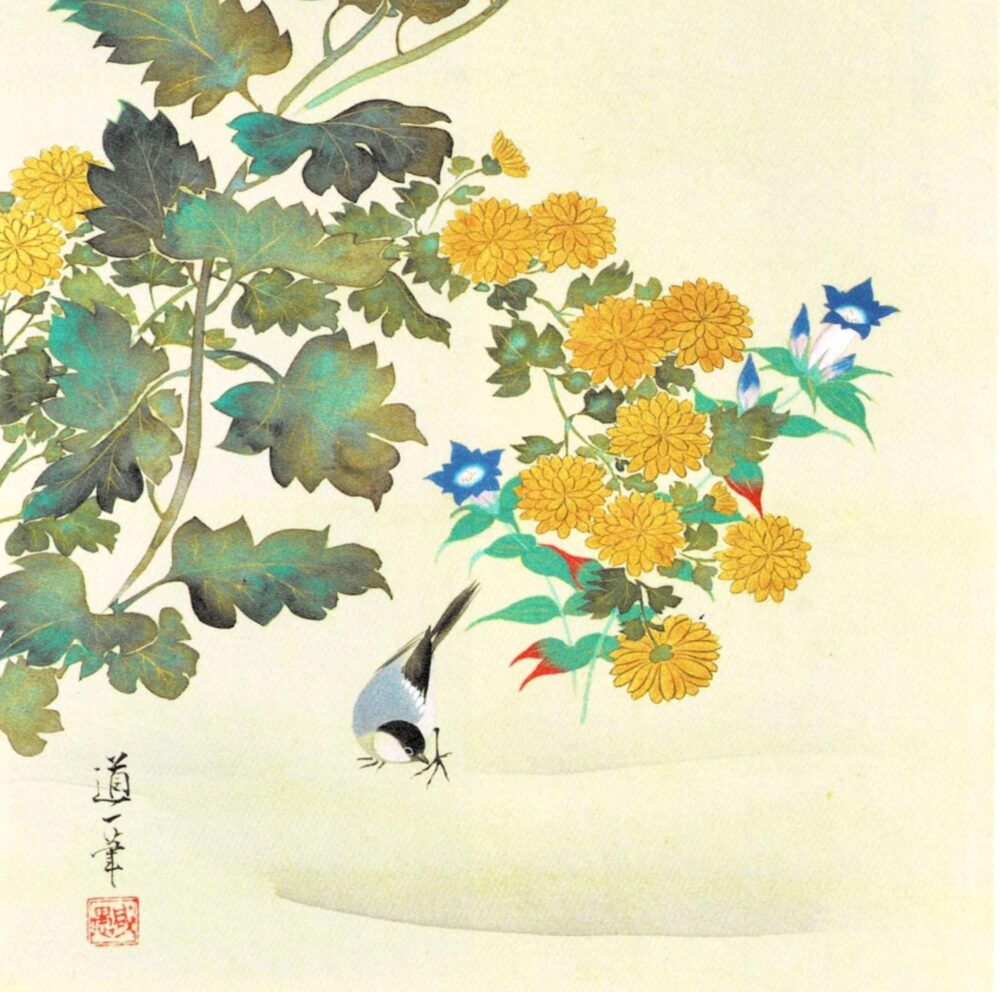
Tradition and Renewal
Overall, this scroll echoes the poetic spirit of Hoitsu Sakai’s Cherry Blossoms and Small Birds, yet introduces a more dynamic rhythm in both composition and color.
Within the quiet spaces of the painting, time seems to flow gently—inviting viewers to pause, breathe, and immerse themselves in its tranquil atmosphere.
Take a moment to stand before it, and you may feel that delicate balance between tradition and innovation—a hallmark of the late Edo Rimpa spirit living on in Meiji Japan.
Summary: Hosomi Museum – A Hidden Gem for Japanese Art Lovers
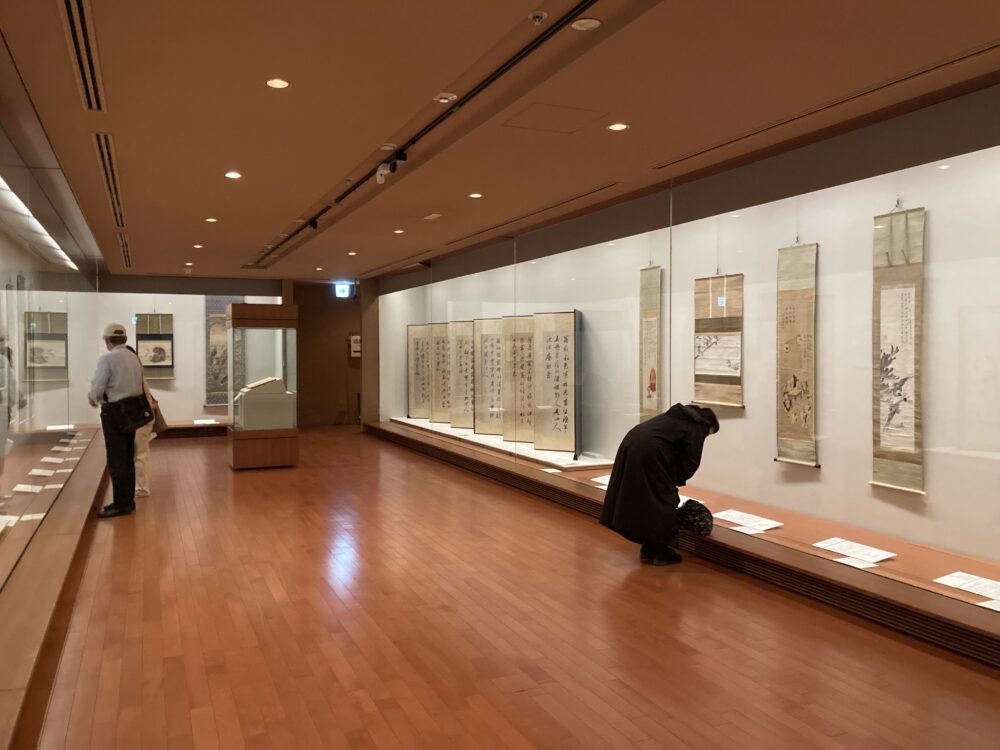
If you want to fully appreciate Japanese art while in Kyoto, the Hosomi Museum is the perfect place to visit.
Its exhibition space, located underground, offers a quiet and calming atmosphere, allowing visitors to explore the essence of Japanese beauty through carefully curated works.
Highlights: Jakuchu and the Rimpa School
The museum’s collection is particularly strong in works by Ito Jakuchu and artists of the Rimpa school.
Even if you’re not familiar with these names, you’ll likely find yourself drawn into their world as you look more closely.
The quality and depth of these collections are truly remarkable—enough to impress even seasoned art enthusiasts.
Beyond Tradition
But the Hosomi Museum isn’t just about traditional art.
It also hosts bold and creative exhibitions, such as special shows on shunga (Edo-period erotic art).
This forward-thinking approach makes each visit feel new and exciting, offering something different every time you come.
If you’re planning a trip to Kyoto, make sure to stop by this hidden gem of Japanese art!
Hosomi Museum – Visitor Information
Location: 6-3 Okazaki Saishoji-cho, Sakyo-ku, Kyoto Prefecture
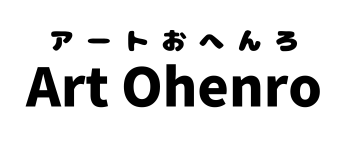






Comments